
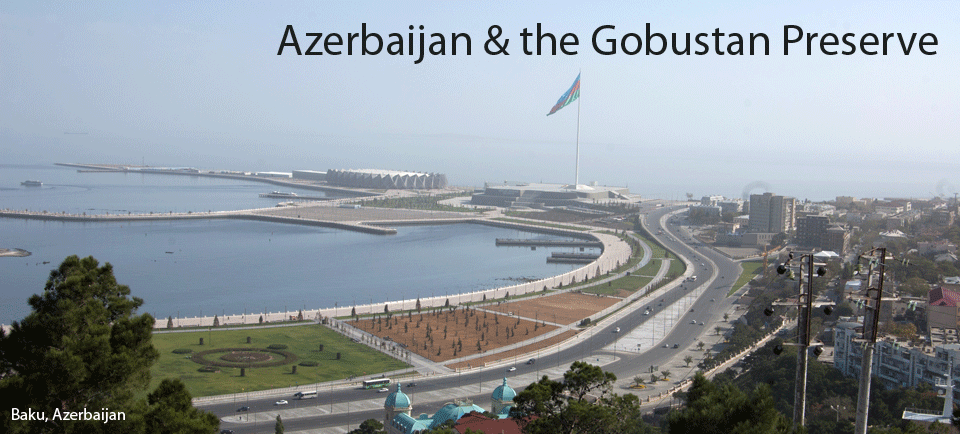
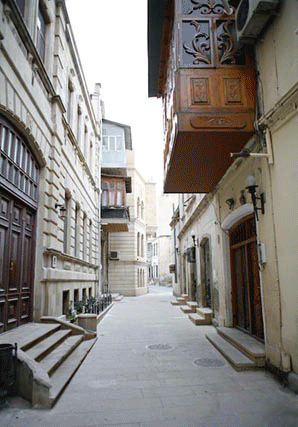
Azerbaijan, located at the crossroads of Western Asia and Eastern Europe, is a meeting place of Asian and European influences. The country’s Gobustan National Historical Artistic Preserve is situated three miles inland from the Caspian Sea and 40 miles southwest of Azerbaijan’s capital city, Baku. Gobustan is a remote, rocky expanse with ravines (gobu means ravine in the Azeri language), mountains, and very little greenery. In this region, a wealth of prehistoric cultural remnants such as petroglyphs, campsites, settlements, and burial sites have been discovered.
In total, there are five mountains in the region, Beyukdash, Jinghirdagh and Yazili-hill, Kichikdash, Shongar, and Shahgaya. The first three, Beyukdash, Jinghirdagh and Yazili-hill, and Kichikdash, are densely adorned with incredible drawings recognized by UNESCO for their “outstanding universal value, integrity, and authenticity.” These three mountains cover an area of approximately two square miles, or 537 hectares. The mountains are encircled by a UNESCO-recognized buffer zone covering just under 12 square miles, or 3,096 hectares. All of this is part of a larger preserve of 17 square miles, or 4,400 hectares.
Field Study in Azerbaijan, Oct. 21-28, 2012: Baku and the Gobustan Preserve
A delegation of Pueblo Indians and Smithsonian staff travelled from the United States to Azerbaijan to study petroglyphs at the Gobustan National Historical-Artistic Preserve (Gobustan Preserve), a UNESCO World Heritage site, and Azerbaijani culture in an inter-cultural, collaborative, team environment.
The American group met its Azerbaijani counterparts, who were competitively selected to participate in the project, and Gobustan Preserve staff.
The week-long field study was packed with cultural and teamwork activities, lectures, and hands-on training. Participants interviewed one another, collected field notes, completed assignments, and exchanged information. Pueblo participant Jonathan Sims documented the activities in video and sound. He interviewed participants and staff. Azerbaijani participant Novruz Pashayev, a film maker and producer, also captured footage. All participants took pictures and had access to digital and video cameras, both personal and purchased by the Office of Policy and Analysis (OP&A) for the project. The field study is summarized below as a day-by-day account to capture the diversity of the activities and the transformational affect the trip had on the participants. Participants wrote reflection papers at the end of the trip. Snippets from their papers are included throughout this section.
The first evening, Sunday October 21, participants met one another at the hotels where they were staying. The participants had short orientation meetings with the Written in Rock (WIR) coordinators and were given orientation packages with the trip itinerary, reading materials, name tags, and notebooks.
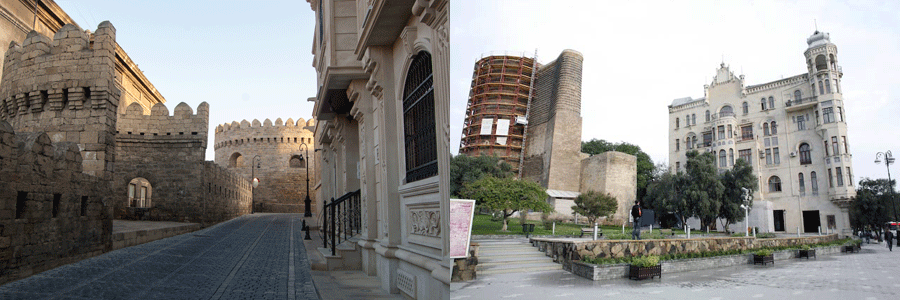
(Left): Old City Baku, Azerbaijan ? (Right): Maiden's Tower, Baku, Azerbaijan
Monday, October 22 was spent at the Gobustan Preserve where everyone formally introduced himself or herself. Gobustan staff presented to the group on topics related to the history, development, management, and scientific significance of the Gobustan Preserve and the recently built Museum. The team toured the Museum and visited the petroglyphs at the Beyukdash Mountain, part of the Preserve. One of the Pueblo participants was struck by the likeness between the artifacts in Gobustan and the objects and symbols found near his home:
Many of the flints, shells, beads, and stone tools are very similar to items found throughout Southwestern United States. One petroglyph […] showed a circular pattern that was strikingly similar to the Sun Dagger which is in the Chaco Culture National Historic Park, New Mexico. […] We were shown some amazing examples of rock art, of which there are thousands located within the Gobustan Preserve boundaries. There were examples that depicted humans, domestic and wild animals, boats, and battle scenes. Some of these examples, if looking at the surrounding landscape in totality, could remind a person of the Southwestern United States. Many of these could (and probably do) have the same types of spiritual meaning to the Azerbaijani people as ones that have spiritual meaning to Native Americans.
The team celebrated the start of the field study with dinner at a restaurant in Old City, Baku. Each person stood up at the table and shared their thoughts about the day. They reflected on what they were hoping to achieve through their participation in the project. Each day following, the participants would reflect as a group on what they were experiencing, which allowed greater understanding to grow among the participants, staff, and coordinators. One Azerbaijani participant reflected about the friendships and mutual respect that developed during the week,
I could not imagine that we would be so close to each other in so few days. Each day, we discussed the day and shared our impressions and attitudes. We were really interested in each other`s interests, cultures, and attitudes. Everyone really respect one another. We were like a big family.
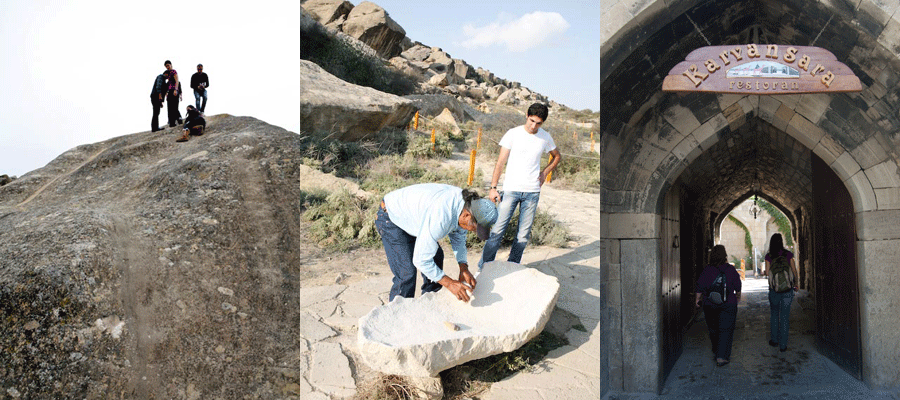
(Left and Center): Participants explore the Gobustan Preserve on their first full day of the program ? (Right): Team members visit the
Karvansara Restaurant after a successful day
On the morning of Tuesday, October 23, Laurie White, rock art researcher/recorder, Sacred Sites Research, lectured about advanced recording techniques that she employs to document heritage landscapes in North America. Laurie demonstrated how to use drawing applications and iPads to trace petroglyphs and their surrounding environments. The participants and Gobustan staff were enthralled by the presentation. That afternoon, Malahat Farajova, Director, Gobustan Preserve, and her staff demonstrated the traditional method of tracing petroglyphs with plastic sheets and markers. Working in pairs of two, the Azerbaijani and Pueblo participants documented rock carvings using both methods and shared their experiences. This experience was a highlight for one Azerbaijani participant: “I think the process of recording petroglyphs was the most exciting and important part of our project.” One Pueblo participant said that the activity helped her connect one-on-one with her partner. Afterwards, the team discussed the critical benefits and drawbacks of both recording methods. For the rest of the afternoon, participants explored the landscape. One Pueblo participant reflected on her experience:
While walking the area, much to my surprise, I located several artifacts made of obsidian on the ground; specifically a fragmented point potentially thousands of years old. I was stunned by the fact that the artifacts and rock art of Gobustan had similarities to those on the North American continent.
Once the sun set, the WIR team examined the petroglyphs again, this time with intense artificial light that highlighted many grooves and markings imperceptible in daylight. One Azerbaijani participant wrote, “It was amazing to see how some illustrations became visible at night.” During the trip, Azerbaijani participants enlivened their understanding of their own culture by experiencing it with the Pueblo visitors. One participant wrote, “I have been to Gobustan many times, but I am grateful to our American friends, with whom I discovered new places in Gobustan.”
The evening ended with a special and festive Yalla dance, a traditional dance that was accompanied by the sound of the gavaldash, a “tambourine stone.” Everyone held hands and danced in a large circle while one participant drummed the gavaldash at a rhythmic pace.
One Pueblo participant wrote about the experience of playing the gavaldash. He identified a parallel between the importance of the drum to Azerbaijanis and the deep respect for the drum in Native American Hopi life:
When you create the beat with the drumstick, it creates the heartbeat of life and it must always be respected in such a manner. The drumstick is the paternal spouse of the maternal drum. Together, they create the sound of life.

(Left and Right): An examination of the petroglyphs at Gobustan during the night reveal markings imperceptible in daylight
On Wednesday, October 24 the team visited Jingirdag Mountain, part of the Gobustan Preserve, to view numerous ancient carvings of sheep and other sacred symbols. The Gobustan Preserve employed local shepherds to monitor the petroglyphs and protect them from defacement. One of these shepherds invited the group to his home for a meal of freshly prepared lamb. This lunch had a profound impact on the Pueblo participants. Many wrote vividly about the experience:
The meal was comprised of fresh cooked lamb that was pan seared or boiled over open fire pits. The meal was served with flat bread and colorful vegetables: cilantro, cucumbers, red tomatoes, and green onions. I was amazed that the miles between our two cultures disappeared and were replaced by the similarities of the Azerbaijani and Pueblo foods and the role it plays in our cultures.
Our host’s house looked like it could be located in New Mexico. […] It reminded many of us of home.
I was in a foreign country, yet I saw a reflection of home. To my left I saw a corral, horses, a barn with many lambs, and to my right, as I came around the bus, a little home, a shack, and, at a distance, an outhouse. Outside the home, I saw an open fire where women were cooking mutton, dressed similar to our women in Kewa. We were invited as special guests into the home and we had a feast. We were fed in a traditional manner; we ate on the ground, just like the traditional way of my people. It was beautiful and very touching to see, smell, hear, and feel the warmth. It was like I was not far away from my own homeland. In my culture, it is our custom to at least give something back for their hospitality. I gave them the precious stone of my people, turquoise, that I had made into pendants.
Watching the sheep cook outside over open flame on the cast-iron skillet, I felt as if I was in a National Geographic expedition. In their home, we sat on the floor, we ate with our hands, and we drank traditional tea. […] that afternoon gave me insight into how close we are connected as human beings. There we were, five thousand miles away from our home, living and eating like our parents and grandparents did before the advent of modern technology turned the reservation into a stop along I-40. For a moment, staring at the mountains where thousands of years ago ancient Azerbaijanis carved their stories into the stones, I felt I had stepped into the river of time, could feel the centuries flow around me and wash everything away. All the remnants of industrialism and modernity blurred and disappeared until there was just the earth, the sea and the sky.
After lunch, the group travelled to the American Center in Baku to deliver a presentation that they created collaboratively. The United States Embassy in Baku sponsored the presentation, and staff from the Embassy attended. The Center was crowded with over 60 people, mainly university students. The audience had a keen interest in the United States and Native American culture. The presentation began with a Hopi blessing and was followed by a brief presentation by each participant. Carolyn McClellan of the Smithsonian Institution’s National Museum of the American Indian told the audience about internship opportunities at the Smithsonian and fielded questions.
One Pueblo participant described her experience:
The presentation attracted all types of students curious to learn and hear about the Pueblos’ culture and the interactions that their fellow Azerbaijanis had with us. We discussed our language, social dances, traditional music, and described Pueblo women’s traditional dress. We had more in common than was expected when we discussed our commitment to the protection of cultural resources. […] This event was one of the highlights of my visit. It provided the WIR participants with the foundation for teamwork towards a common mission and purpose, regardless of the barriers presented by language. It also prepared us for the long hours of work that lay ahead.
Attendees stayed after the presentation to ask questions, speak to the Smithsonian staff about internships, and have their pictures taken with the Pueblos. Chris Jones, Cultural Affairs Officer from the United States Embassy in Baku, and Claire Eckert, Smithsonian Institution’s Office of Policy and Analysis, spoke with the participants about resources that were available to fund future efforts that would build upon the momentum created by the WIR project. The participants found this information valuable, especially as they plan on how to bring what they learned during field study back to their communities.
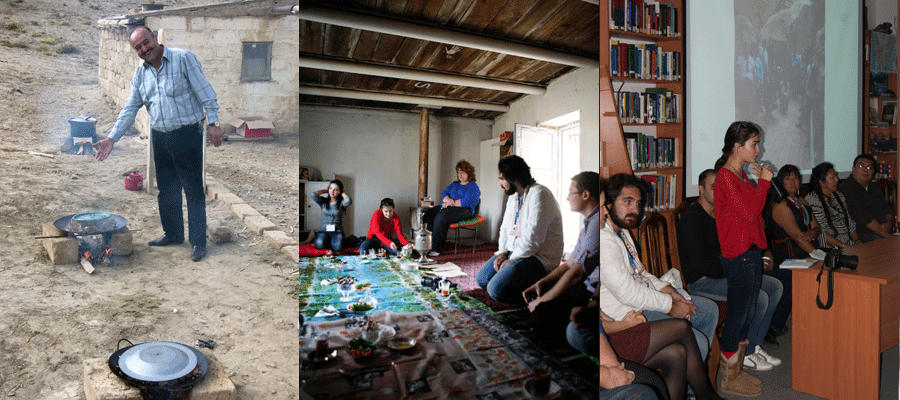
(Left): Local sheperd preparing lamb for team members ? (Center): Participants treated to lunch in local traditional manner ?
(Right): Participants presenting at the American Center in Baku to local University students
On Thursday, October 25 the WIR team visited historical sites, including the Atashgah Zoroastrian fire temple, the remains of an ancient Roman tower, and the petroglyphs of Dubandi, all located by the Caspian Sea, and the Gala Ethnographic Preserve and Museum. This day was extremely busy and enriching. The participants met with the Director of the Gala Preserve and throughout the day were exposed to many new ideas and historical information that created a cultural context in which to place the petroglyphs at Gobustan.
Later in the day, participants met in small groups to discuss the day’s activities and their personal goals for the project. One person from each group was selected to report-out to the larger team about his or her group’s discussions. This activity led to a fruitful and thoughtful discussion about the importance of maintaining a connection to one’s heritage and protecting it for future generations. One Azerbaijani participant wrote:
During my experience in Gobustan, I understood that we should take steps to safeguard and restore our places that carry cultural and historical significance and safely convey it to the next generation. We must realize that this is our history and where we have come from. We can contribute, influence, and spread this knowledge through presentations, promotional factors, etc.
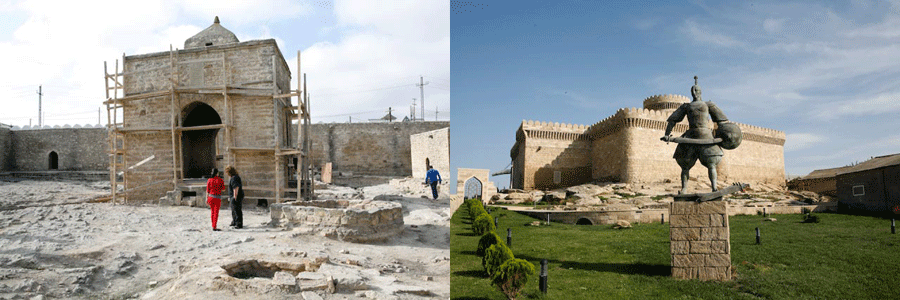
(Left): Atashgah Zoroastrian fire temple ? (Right): Gala Ethnographic Preserve and Museum
On Friday, October 26 the WIR team trekked up a mountain to view the famous mud volcanoes and volcanic lake of Azerbaijan. This was a surreal experience for many of the participants. Participants discussed the benefits and dangers of promoting tourism to natural and geological marvels, such as the mud volcanoes. In the afternoon, the participants attended lectures at the Gobustan Preserve. Malahat Farajova and her staff demonstrated how Google Earth and GPS technologies were transforming the management of cultural heritage. The presentation sparked a lively discussion among the participants about monitoring heritage sites and the pros and cons of public data about the location of petroglyphs. One Azerbiajani participant felt that the participants’ discussions could stimulate new ideas. She wrote:
I believe that understanding the similarities and differences [between Azerbaijani and Native American petroglyphs and culture] may help develop something new, which I could apply in futuristic technology.
Friday was the last, formal day for the field study. The farewell dinner was celebratory and sorrowful. Each participant and staff member stood up and conveyed what they had learned and gained over the week. It was a very emotional evening filled with jokes, smiles, tears, dancing, and hugs. An Azerbaijani participant wrote, “The moment of goodbye was the most emotional experience.” One Pueblo participant commented on the evening:
At the end of our study week, we ate our final group dinner. In the background, an Azerbaijani band sang their traditional songs. We ended the night by dancing one of the traditional dances, known as Yalla. […] This memory will stay with me forever. I hope to visit Baku again, so I can finish the Yalla dance where I left off.
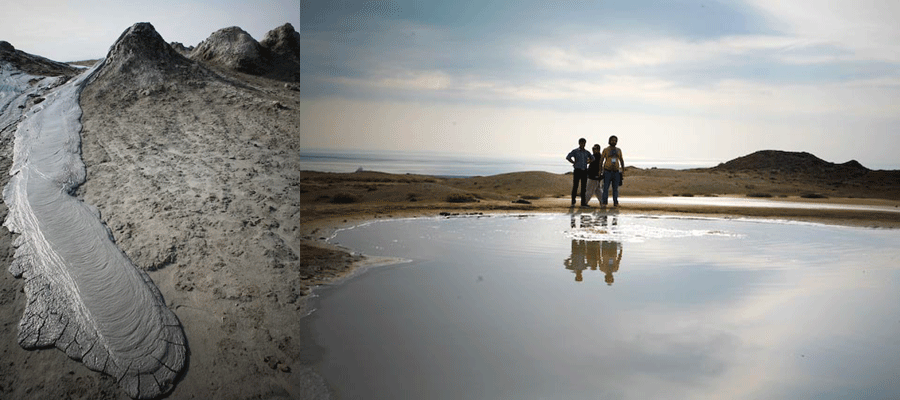
(Left and Right): Mud volcanoes
On Saturday, October 27, the Azerbaijani and Pueblos participants spent the day exploring Baku, attending museums, specifically the National Carpet Museum, exchanging gifts, and selecting souvenirs for family and friends. The Azeribajani participants returned to their homes and the Pueblo participants prepared for their return flight to the United States.




